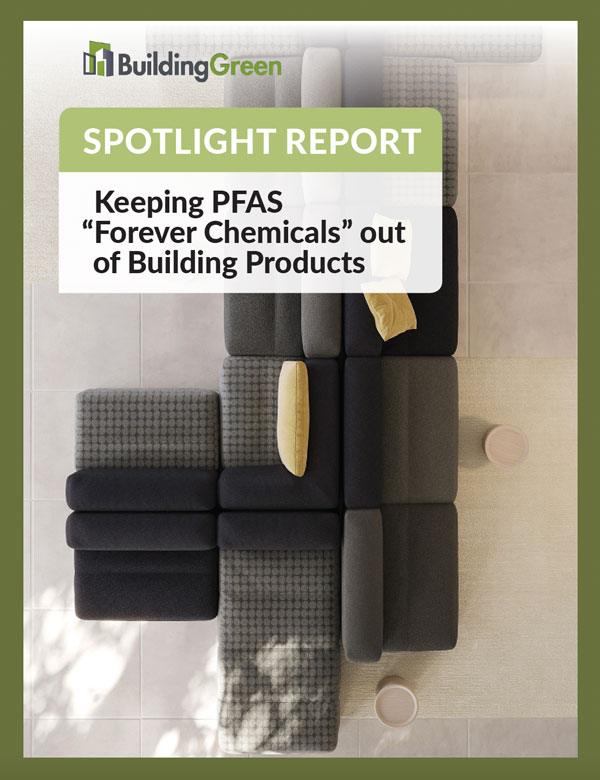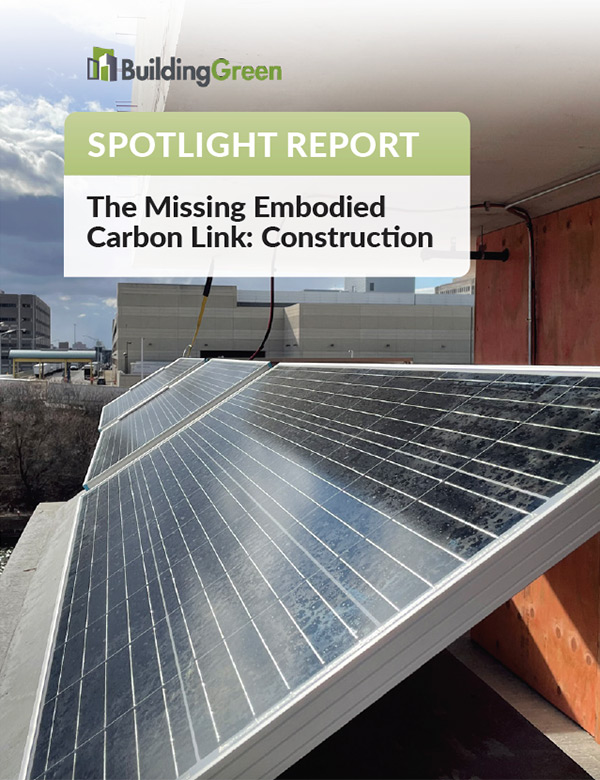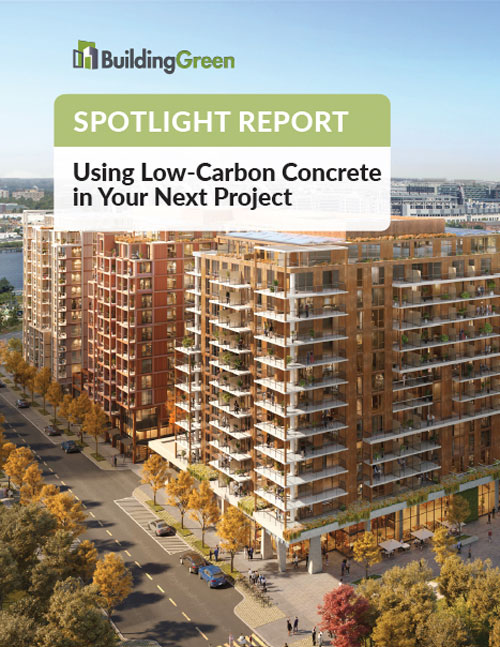Championing the Changemakers
Championing the Changemakers in Sustainable Design & Building


Image: Piranka

BuildingGreen Campus-Wide Access
Access provided by
Auraria Library

Photo: Andriy Miyusov
Feature
Policy Shifts
The current presidential administration has made many changes to preserved policies in the EPA, NSF, and more branches. Catch up on what may have been missed.
Read more »
News Brief
C2C Launches a New, More Accessible Circularity Certificate
With its Certified Circularity Standard, Cradle to Cradle hopes to expand the reach of its product circularity efforts.
Read more »
News Brief
Industry Aligns on Federal Zero-Emissions-Building Definition
Leading industry nonprofits have committed to supporting the Biden Administration’s definition of a zero-emissions building as they evolve their programs, including LEED v5, Living Building Challenge, and Passive House.
Read more »

Feature
The Four Core Issues to Tackle for Resilient Design (And the Programs That Can Help)
As rating systems from LEED to RELi lay out key design steps for resilient design, it’s still up to project teams to bring critical perspective.
Updated May 27, 2025
Read more »

Feature
Designing for the Next Century's Weather
How do you create a climate-responsive building in a changing climate? Brand new modeling techniques are helping us figure it out.
Updated May 21, 2025
Read more »
News Analysis
Equitable Neighborhood Decarbonization Gets the Go-Ahead
A new California law will allow utilities to replace aging gas infrastructure with zero-emission alternatives in 30 pilot projects
Read more »
Product Review
You Can Now Specify Low-Embodied-Carbon Steel
ClarkDietrich’s low-embodied-carbon cold-rolled steel products meet Build America, Buy America Act and Buy Clean Act federal purchasing requirements.
Read more »

Feature
Resilient, Sustainable Water Management: A Holistic Approach
Climate change has redefined how we view water, with drought amplifying water scarcity and changing our relationship with the landscape and the built environment.
Updated May 7, 2025
Read more »

Feature
Design for Adaptation: Living in a Climate-Changing World
Solutions for designing buildings that not only mitigate our impact on the global climate, but also adapt to the changes that are coming (and those that are already here).
Updated April 23, 2025
Read more »
On-Demand Webcast
IRA Nuts & Bolts with an Energy Tax Expert
Free to Premium subscribers, CEUs available.
Watch the webcast

Explainer
Circular Economy: Better Design from Start to … Start
Circularity is about far more than just recycling. It means building and buying things only when necessary—and without wasting anything.
Read more »

Feature
Assessing Climate Hazards: The First Step in Resilient Design
The tools for conducting a multi-hazard exposure analysis are available if you know where to look.
Updated April 2, 2025
Read more »

Feature
An Advocate’s Guide to Resilience Regulations
Resilience is finding its place in city zoning and building codes. Here are some ideas to bring to your local government.
Updated April 2, 2025
Read more »
On-demand Webinar
Wood's Latest Move: From Carbon Neutral to Climate Smart
Free to premium subscribers!
Watch the webcast

Now Updated!
WELL v2 AP Study Guide
Buy It Now - $99
Know what you need to know, where to find it
Photo: Benjamin Benschneider


Whether they intend to or not, project teams often make design decisions informed by an assumed time value of carbon, like when calculating a carbon payback period, the Arup report emphasizes. (Image: Arup)
News Analysis
Carbon Now or Later: The Arguments for Delaying Emissions
A new Arup report demystifies the time value of carbon, why it matters, and why we need to be careful with it.
Read more »

Shaw is selling its new EcoWorx Resilient at a price it claims is comparable to that of domestically made luxury vinyl tile. (Image: Shaw Contract/Shaw Industries)
Product Review
New Recyclable LVT Replacement Is PVC Free—and Affordable
Shaw claims its EcoWorx Resilient flooring performs better than vinyl and that the material can—and will—be recycled.
Read more »
The BuildingGreen Guide
to Building Product Certifications and Ecolabels
Buy it now. Discounted for $69.
CEUs available.


MASS selects natural and biobased materials, merging contemporary and traditional design while reducing environmental impacts and supporting local communities. (Photo: MASS Design Group and Iwan Baan)
Spotlight Report
The Promise of Biobased Materials—and How to Use Them Now
There is a lot of hype over carbon storage and other benefits of natural materials, but their potential is real. Here are some that are ready for prime time—and the ones we hope will take off next.
Read more »
Explore our full knowledge base »
Maintain Your Credentials

Wood: Is It Still Good? Part One: Embodied Carbon
Wood products are widely regarded as carbon neutral—or even better. With new research challenging that idea, a more cautious approach is emerging. Because the climate stakes are too high for us to get this wrong.

Keeping PFAS Forever Chemicals out of Building Products
Per- and polyfluoroalkyl substances (PFAS) have been linked to negative health and environmental impacts. Getting them out of our building products is going to require work.

The Missing Embodied Carbon Link: Construction
Some researchers say construction emissions could account for as much as 30% of a project’s embodied carbon. What can be done about it?

Using Low-Carbon Concrete in Your Next Project
Advancements in low-carbon concrete materials and strategies have led to greater adoption in much of the U.S. Now it's time to start using them.

Integrative Process: Pathways to Performance and Regeneration
An integrative process can streamline workflows and drive higher performance. But if you do it well, it’s so much more.

ESG: 6 Things Building Professionals Need to Know
Clients need AEC professionals to help them achieve environmental, social, and governance goals. Here’s how people are turning aspirations into strategies.

We Must Decarbonize Existing Buildings by 2050—but How?
Deep energy retrofits and existing building electrification are critical to curbing carbon emissions. Here’s how to make the case and get it done.

Assessing Climate Hazards: The First Step in Resilient Design
The headlines are everywhere—from heat waves in Europe to wildfires in the Western U.S. to tidal flooding in Florida. In this age of climate change, just as there’s an urgent need to reduce carbon emissions and other greenhouse gasses, we also need to adapt and invest in resilience.

Constructing Change: The Contractor’s Commitment
Health and wellness are in high demand in sustainable design. Soft daylight, superb indoor air quality, enhanced thermal comfort, great ergonomics … all these design elements and more are becoming standard for students, patients, and office workers. There is a stubborn gap between green design and green building. But a group of industry leaders is out to close it with a program called the Contractor’s Commitment to Sustainable Building Practices. In this course, you’ll learn all about the new commitment—who’s signed, why it’s important, and the impact it’s already having on the industry.

Is Using Smart Glass Smart?
The sun streaming into our buildings can be both a benefit and a nuisance. Controlling its glare and solar heat gain in order to maximize energy efficiency, occupant comfort, and views to the outdoors is difficult. In commercial offices and all-glass buildings, the impacts are multiplied. Low-e glazing and exterior or interior shading systems are most often used to manage daylight, but there is another option—electrochromic glazing, sometimes called smart glass, switchable glass, dynamic glazing, and other names (in this report, we’re going to call it “smart glass” and are not covering thermochromic and other light-blocking glazing technologies).

Waste Not, Want Not: Case Studies of Building Material Reuse
The construction sector’s take-make-waste approach to materials needs an overhaul. Materials and construction account for an estimated 11% of global greenhouse gas emissions annually. At the other end of the life cycle, demolition in the United States annually generates 90% of some 600 million tons of construction-sector debris. Getting trashed alongside are the cultural, economic, and environmental values those materials embody. Indications are, though, that this staggering, decades-long profligacy is about to change.

No more red lines: Undoing Our Legacy of Urban Segregation
Although disparities between predominantly white and predominantly non-white neighborhoods go back hundreds of years, 20th-century government-sponsored discrimination was a key turning point in segregating our cities, creating the maps we have today. In fact, it all began with maps—maps released during the New Deal era by the Federal Housing Agency (FHA).

The beneficial intersections of Energy, Resilience, and Health
How can the returns of sustainable building strategies with less quantifiable benefits, like resilience and wellness, be paired with more predictable returns of energy efficiency to calculate an overall return on investment? Where are we in the market in terms of sustainable building codes, and how much do we need to improve beyond code to get to high-performance, resilient, and wellness-oriented designs?

The Building Green guide to thermal insulation
The BuildingGreen Guide to Thermal Insulation provides detailed guidance on insulation products and practices, including recommendations on what insulation to use and what to avoid. It's a treasure trove of information for architects and designers, builders, and anyone who is actively considering the impact of insulation on the quality of your indoor environment and the world.

Spec this not that
Designers and specifiers from numerous leading firms are figuring out that it is possible to identify healthier products and materials and still create gorgeous, energy-efficient, occupant-friendly buildings—without busting budgets or getting overwhelmed by complex health and chemical data.

Lighting Design for Health and Sustainability: A Guide for Architects
What do we mean when we say sustainable lighting? In this PDF report, we take a closer look at lighting as an essential element in quality environments that support health and wellness while reducing energy use.







